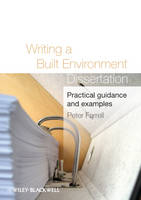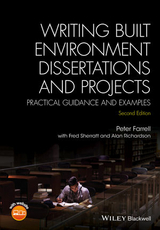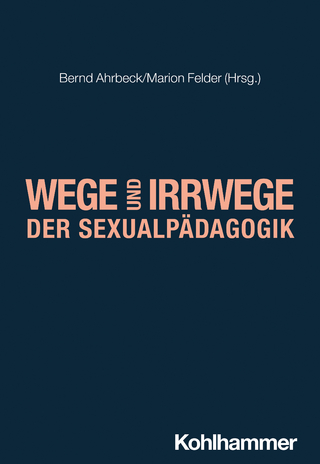
Writing a Built Environment Dissertation
Wiley-Blackwell (an imprint of John Wiley & Sons Ltd) (Verlag)
978-1-4051-9851-6 (ISBN)
- Titel erscheint in neuer Auflage
- Artikel merken
As a built environment student you are likely to be required to research, write and submit a dissertation as a core component of your degree studies. As a vocational profession, students of the built environment often have strong practical aspirations. Writing a Built Environment Dissertation provides practical guidance and will help to steer you into a position where you can develop a good dissertation by mixing your practical strengths with more theoretical tools. The book is ordered around a common dissertation structure: that is, it starts with material that should be in the introduction and finishes with material that should be in the conclusion. Each chapter provides a commentary on the kind of information that you should put in each chapter of your dissertation, supported by a variety of examples using a range of methodological designs. The book has a strong focus on data collection, data analysis, reliability and validity - all areas where student dissertations are often weak.
Material that will help you think about study skills and ethics is embedded throughout the book, and the chapters on qualitative and quantitative analysis will show you how to carry out a rigorous analysis while avoiding some of the complexity in statistical work. If you are an under-graduate student in the final year of an honours degree programme in the built environment, or perhaps a student at masters or PhD level and have been away from academic study for some time, then this book will help you to write a more innovative and thorough dissertation.
Dr Peter Farrell, MSc, FRICS, FCIOB, FRSA, is Senior Lecturer in the Department of the Built Environment at the University of Bolton. He is the programme leader for the MSc in Construction Management and has taught research methods to undergraduate and postgraduate students for over ten years. He also delivers modules in construction management and commercial management. His industry training was in planning and quantity surveying, whilst most of his post-qualification work was as a contractor's site manager.
Author biography xi Preface xiii 1 Introduction 1 1.1 Introduction 1 1.2 Terminology; nomenclature 2 1.3 Document structure 2 1.4 Possible subject areas for your dissertation 5 1.5 Qualitative or quantitative analysis? 6 1.6 The student/supervisor relationship and time management 9 1.7 Ethical compliance 11 1.8 House style or style guide 14 1.9 Writing style 15 1.10 Proofreading 18 Summary of this chapter 19 2 The introduction chapter to the dissertation 20 2.1 Introduction contents 20 2.2 Articulation or description of the problem and provisional objectives 21 Summary of this chapter 23 3 Review of theory and the literature 24 3.1 Introduction 24 3.2 Judgements or opinions? 27 3.3 Sources of data 28 3.4 Methods of finding the literature 29 3.5 Embedding theory in dissertations 30 3.6 Referencing as evidence of reading 34 3.7 Citing literature sources in the narrative of your work 35 3.8 Secondary citing 36 3.9 Who to cite in your narrative 37 3.10 References or bibliography or both? 38 3.11 Common mistakes by students 39 3.12 Using software to help with your references 40 3.13 Avoiding the charge of plagiarism 42 Summary of this chapter 45 4 Research goals and their measurement 46 4.1 Introduction 46 4.2 Aim 47 4.3 Research questions 48 4.4 Objectives 48 4.5 Objectives with only one variable 51 4.6 Objectives with two variables 51 4.7 Hypotheses 52 4.8 Independent and dependent variables 54 4.9 Lots of variables at large; intervening variables 57 4.10 Subject variables 59 Example 1 59 Example 2 61 4.11 No relationship between the IV and the DV 63 4.12 Designing your own measurement scales 63 4.13 Levels of measurement 67 4.14 Examples of categorical data in construction 68 4.15 Examples of ordinal data in construction 69 4.16 Examples of interval and ratio data in construction 71 4.17 Money as a variable 72 Summary of this chapter 74 5 Methodology 75 5.1 Introduction 75 5.2 Approaches to collecting data 77 5.3 Types of data 79 Primary or secondary data 79 Objective or subjective data; hard or soft 79 5.4 Questionnaires 82 Piloting the questionnaire 83 Coding questionnaires 84 A basket of questions to measure variables or multiple item scales 86 Using a basket of questions in ordinal closed-response scales 90 Other possible responses in ordinal closed-response scales 93 Ranking studies 93 5.5 Other analytical tools 95 5.6 Incorporating reliability and validity 96 5.7 Analysis, results and findings 99 Summary of this chapter 100 6 Qualitative data analysis 101 6.1 Introduction and the process 101 6.2 Steps in the analytical process 104 Summary of this chapter 111 7 Quantitative data analysis: descriptive statistics 112 7.1 Introduction 112 7.2 Glossary of symbols 113 7.3 Calculations done manually or by using software 114 7.4 Descriptive statistics 115 Ranking 121 Normal distributions: measures of central tendency (mean, median and mode) 121 Measures of spread: range, standard deviation, variance 124 Standard score: the Z score 127 Confidence intervals 128 General use of descriptive statistics 129 Summary of this chapter 131 8 Quantitative data analysis: inferential statistics 133 8.1 Introduction 133 8.2 Probability values 134 The p value of - 0.05 135 Setting the significance level of p; alternatives to 0.05 136 8.3 The chi-square test 137 Assembling the raw data 139 Transferring raw data to the contingency table: stage 1 139 Are differences due to chance? manual calculations: p values and degrees of freedom 140 The consequence of larger sample size and different spread of numbers 143 More complex or more simple chi-square 144 8.4 Difference in mean tests: the 't' test 146 Unrelated or related data 147 Determining whether the data set is parametric 148 Which difference in means test? 154 8.5 Difference in means: the unrelated Mann-Whitney test 157 Assembling the raw data 157 Are differences due to chance? Manual calculations: p values and degrees of freedom 159 The consequence of larger sample size and different spread of numbers 162 8.6 Difference in means: the related Wilcoxon test 162 8.7 Difference in means: the parametric related t test 165 8.8 Correlations 165 Are differences due to chance?; and the correlation coefficient 168 Manual calculations for Spearman's Rho 169 The consequence of larger sample size and a wider spread of data 173 8.9 Difference in means, correlations or both? 176 8.10 Using correlation coefficients to measure internal reliability and validity 177 8.11 Summarising results 182 Summary of this chapter 182 9 Discussion, conclusions, recommendations and appendices 183 9.1 Introduction 183 9.2 Discussion 184 9.3 Conclusions and recommendations 185 9.4 Appendices 188 9.5 The examiner's perspective 189 Initial overview 189 Review of literature 189 Design of study 189 Presentation of results 190 Discussion and conclusions 190 Summative overview 190 Summary of the dissertation process 190 Summary of this chapter 191 References 192 Bibliography 195 Appendices 196 Appendix A: research ethics checklist 197 Appendix B: narrative of a problem 198 Appendix C: a review of theory and literature 200 Introduction and the problem 200 The literature 201 Motivation 201 Social class 202 Appendix D: qualitative analysis 207 File 1: research objectives 207 File 2: interview questions and prompts 207 File 3: verbatim transcripts of interviews first copy 208 File 7: verbatim transcripts of interviews third copy; originating from file 4, person A only 224 File 9: a new file, comprising tables 231 File 10: the narrative 237 Appendix E: using Excel for charts, descriptive tests and inferential tests 240 Four charts 240 Frequency histograms 240 Line diagrams 240 Pie charts 241 Scatter diagrams 241 Eleven descriptive tests 243 The five inferential tests 245 Pearson's chi-square test 245 Wilcoxon test, unrelated t-test and Mann-Whitney test 245 Pearson's product moment correlation test-two routes both giving the same answer 247 Appendix F: the standard normal distribution table 249 Appendix G: chi-square table 250 Appendix H: Mann-Whitney table, p = 0.05 251 Appendix I: Mann-Whitney table, p = 0.01 252 Appendix J: Wilcoxon table 253 Appendix K: related t test table 254 Appendix L: Spearman's rho table 255 Appendix M: Pearson's r table 256 Appendix N: F distribution 257 Index 259
| Erscheint lt. Verlag | 31.12.2010 |
|---|---|
| Zusatzinfo | Illustrations |
| Verlagsort | Chicester |
| Sprache | englisch |
| Maße | 170 x 242 mm |
| Gewicht | 476 g |
| Themenwelt | Sozialwissenschaften ► Pädagogik |
| Technik ► Architektur | |
| Technik ► Bauwesen | |
| ISBN-10 | 1-4051-9851-6 / 1405198516 |
| ISBN-13 | 978-1-4051-9851-6 / 9781405198516 |
| Zustand | Neuware |
| Haben Sie eine Frage zum Produkt? |
aus dem Bereich



